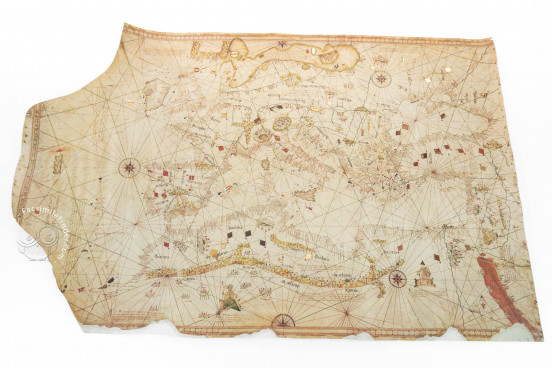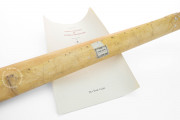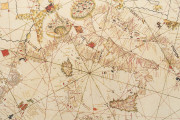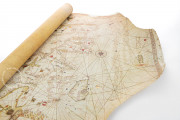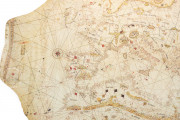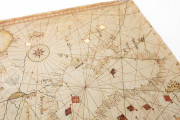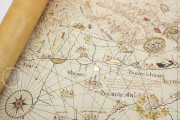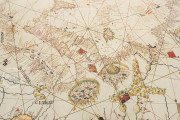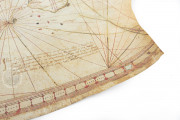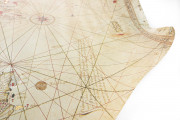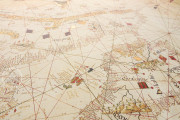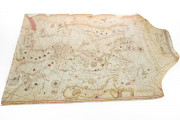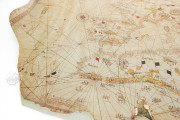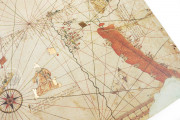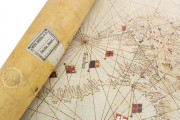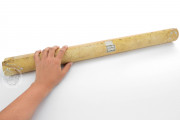This nautical chart, made by the Italian chart maker Andrea Benincasa in 1508, is a very interesting example of the late medieval Mediterranean cartographic tradition. Although it is a rather late case, given that most of the portolan charts of this style were produced in the fourteenth and fifteenth centuries, this chart summarizes the geographical knowledge about the Mediterranean available at that time. With abundant illustrations and place names, it includes several explanatory texts about Europe, parts of Asia, Northern Africa, and some islands of the Atlantic. It is a luxury chart, one that would have been owned and displayed by a noble, rather than one that would have been taken to sea and used for navigation.
The chart is signed and dated on an inscription at its left edge, according to which it was made in the city of Ancona in 1508 by Andrea Benincasa. Andrea was the son of Grazioso Benincasa, one of the most important chart makers of the fifteenth century. Consequently, the style of Andrea’s chart is heavily influenced by his father’s work.
A Great Example of Traditional Nautical Charts
The chart is made on one sheet of parchment, and measures 64.2 x 99.3 cm. It depicts the coasts of in a very accurate way, even though it is quite a traditional cartographic representation.
Several important cities, like Genoa and Venice, are prominently depicted, and the most important cities and kingdoms are indicated with their respective flags. Some islands are filled with the colors of the kingdom they belong to, as we can see in Majorca, which is colored with the coat of arms of the Crown of Aragon.
In northern Africa, the Atlas Mountains are prominently drawn, and two enthroned kings, as well as an elephant near the Red Sea, are also depicted. A third ruler, in this case, the Emperor of the Tartars, is represented in northern Asia, although he is not colored.
The Atlantic is filled with islands and archipelagos, from the Canaries in the south (still named the “Fortunate Islands”) to the northern Atlantic islands, and the coexistence of mythical references and real places is still noticeable, both in the explanatory texts (written in Latin) and in the places represented. Thus, the Canaries, even though they are represented in a “modern” way, are still identified with St. Brendan, who, according to the legend, sailed the Atlantic and reached Paradise in the sixth century.
On the other hand, we can see both a textual and a graphic indication of the Lacus fortunatus (Fortunate Lake) in Ireland, also a usual reference on the nautical charts of Andrea’s father, Grazioso Benincasa. This chart is held in the Vatican Library under the shelfmark Borg. VIII.
Andrea Benincasa: Chart Maker and Sailor
Andrea Benincasa was a member of an important family of cartographers. It is believed that his father, Grazioso Benincasa (c. 1400-1482), was not only a renowned chart maker, but also a sailor, at least until he lost his ship to corsairs about 1460. Andrea followed the steps of his father, becoming a galley commander and a chart maker in his native Ancona.
The style and features of Grazioso’s charts are clearly visible in Andrea’s, as we can see in his three extant works: an atlas of 1476 held in the Bibliothèque Publique et Universitaire of Geneva, a chart of 1490 in the Museo Archeologico delle Marche in Ancona and this chart of 1508 in the Vatican Library.
We have 1 facsimile edition of the manuscript "Sea Chart of Andrea Benincasa": Seekarte des Andrea Benincasa facsimile edition, published by Belser Verlag, 1984
Request Info / Price
